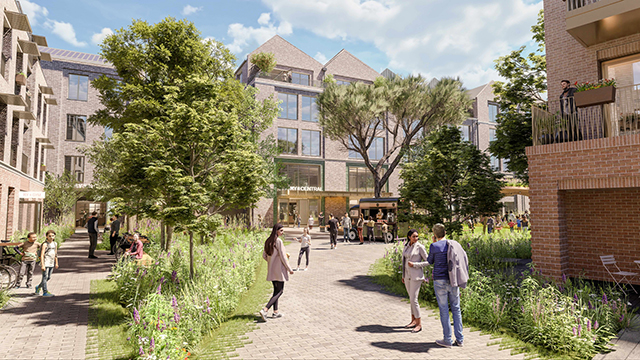
Estate regeneration has the potential to bring thousands of homes back into circulation and make a big dent in the housing crisis. But avoiding the mistakes of the past means it is a far from simple process. Alexander Peace reports
KEY POINTS
- Estates renewal should not repeat mistakes of the past
- Clear leadership is required from the public sector
- Pay-off is stable pipeline for lower returns
The council estate building programmes of the 1960s and 1970s were grand in scope but poor in execution. What were meant to be icons of social mobility and the burgeoning welfare state became oppressive reminders of poverty, crime, and segregation.
Nearly 50 years after they began sprawling across the urban landscape, there is once again a focus on estates and how best to rebuild them.
David Jubb, director of Greater London residential development at JLL, says: “As a nation, we are not building enough – there is no secret there – and the powers that be are increasingly looking at regenerating estates on a national scale, both to increase the quality of housing and fundamentally to build more.”
With local authority budgets slashed and central government spending still a no-go, the time and opportunity is now for the private sector to take a hand in bringing forward many of these schemes.
A task force led by Lord Heseltine has been set up to initiate redevelopment, while more and more councils are waking up to the benefits of public/private partnerships.
The issue is making sure the well-intentioned mistakes of the past are not repeated.
In many respects, the renewed interest in estate regeneration could not have come at a better time. On the one hand, the government has shown more flexibility in allowing councils to build and a growing acceptance of partnership models. On the other, a slowdown in the wider residential market, especially in London, means many housebuilders are looking for longer-term and secure income sources.
Bilfinger GVA is advising on two large estate regeneration opportunities in south London that have attracted housebuilders, as well as big regeneration players, to the shortlists.
“It can appeal across the sectors,” says Gerry Hughes, chief executive at Bilfinger GVA. “Housebuilders will increasingly look at these partnership models, which are attractive from a longer-term view. I think it is something we will see more of.”
Félicie Krikler, a director at Assael Architecture, says that because public money alone will not be able to solve the issues around estates renewal, the opportunities are significant for the private sector. “Private investment has the power to accelerate housing supply and instigate improvements to placemaking,” she says.
The opportunity is massive: instead of stretched government funding half-heartedly trying to rebuild, housebuilders and developers, in partnership with councils and looking to de-risk part of their future income, can rebuild the next round of estates.
However, there is a big difference between regular commercial property development and estate regeneration.
Developer Countryside has completed around 45 estate regeneration schemes, many of which have been through partnerships in one form or another.
“We started doing these schemes in the early 1990s and it has not any easy market to break into,”says chief executive Richard Cherry. “We have people’s lives in our hands, in a sense. New community initiatives, a lot of training, labour initiatives, then the economics of making these things work.”
Barry Jessup, director at First Base, adds: “People confuse estate regen with building houses. It does not start with residential – in nearly all cases, it starts with employment and jobs, or culture.”
One of the key opportunities, says Cherry, is righting the wrongs of past building: plonking down two separate housing estates, public versus private, will not create a cohesive society.
“Is it estate regeneration, or a new community?” asks Bob McCurry, planning director at Barton Willmore. “There are two types in my mind. One is the wholesale redevelopment; the other is the interventionist approach – infilling, etc. And that is the real challenge, because you have to knit together the existing and new communities.”
Alongside community engagement comes the more practical issue of financial viability. While in central London knocking down half pays for the other half, there is no such luxury elsewhere.
“The value you generate from the land goes nowhere near the surplus to cross-subsidise the other housing,” says Paul Beardmore, chief executive at developer Manchester Place. “It takes public sector money, to at least kick-start it, to get the thing going, and probably needs to be invested over a long period of time.”
As a result, the government task force’s £140m is unlikely to go very far, and either government or local authorities will have to stump up the cash if they want more to happen. There are ways they can do this – for instance, through borrowing, land deals or deal structures – but it means commitment.
While there is no single route to estate regeneration success, assuming the private sector will bring the money and development expertise, successful schemes will hinge on the public sector.
Beardmore says the key is de-risking the investment from day one: showing the local authority has a strong plan and leadership, and is willing to issue the compulsory purchase orders.
“They have to have confidence that the local authority is going to deliver on that commitment – because if they don’t there is a big risk about the position,” he says.
What the private sector wants is stability – if the local authority can smooth out the kinks, there will be fewer problems.
Hughes says: “The public sector has to be absolutely clear on what its offer is, do its homework on what key questions are going to be coming its way, and work in partnership with the private sector.”
When local authority budgets have been slashed and building programmes curtailed, it is a big ask for the public sector to take the lead, but local authorities’ ability to bring the community with them means they are essential.
Technically, if schemes have been de-risked enough, the private sector will take lower returns: after all, what they are trying to secure though estate regeneration is a long-term, stable pipeline.
We are in a well-publicised housing crisis and estate regeneration looks set to be an increasingly viable route to market for the redevelopment, and new building, of thousands of homes. But a pressing need for homes should not mean a rush job and a repetition of the mistakes of the 1960s and 1970s.
There are good and bad examples of public-private partnerships, and it is a far from simple process. Developers cannot be allowed to trample existing communities in an opportunistic hunt for profit, but nor can councils ignore the financial necessities of schemes.
Heseltine’s task force
A panel was launched in February this year, headed by Lord Heseltine, to look into how estate regeneration can deliver more homes. Its aim is to develop a national estate regeneration strategy to work with the UK’s 100 worst estates and transform them.
While widely lauded, its £140m budget will not go far, and the panel has gone quiet amid the political shake-up following the EU referendum. But perhaps more important than the size of its funding is the fact that it shows that the government broadly supports the regeneration of estates.
The model
Across the country, the propositions and routes to market vary, but the basic model, as with most public-private partnerships, is for the council to provide land and the private sector to provide the funding and construction.
But to look at this as a straightforward public-private partnership could be simplistic.
Bob McCurry, planning director at Barton Willmore, says that from a development perspective, the partnership approach works, because developers are able to share the risk. “Ultimately, the council hands its land over,” he says. “Then if there are abnormalities, the developer is able to take that off the land value. This works well, as it means schemes are not stopped halfway by unseen costs. And it allows councils to have an input.”
CPOs
Few aspects of estate regeneration are as disastrous as compulsory purchase orders.
Because of Right to Buy, the ownership of estates is enormously fragmented. Single uncooperative owners can delay building works by years – or even derail them completely.
Paul Beardmore at Manchester Place describes them as the “fly in the ointment” of estate regeneration.
The latest Neighbourhood Planning Bill included provisions for simplifying the process.
This is not to say, of course, that there is not a valid reason for residents to be uncooperative – notably when planners have not consulted or worked with them – but councils keen on regeneration need to show a willingness to get their hands dirty.
• To send feedback, e-mail alex.peace@estatesgazette.com or tweet @EGAlexPeace or @estatesgazette
















